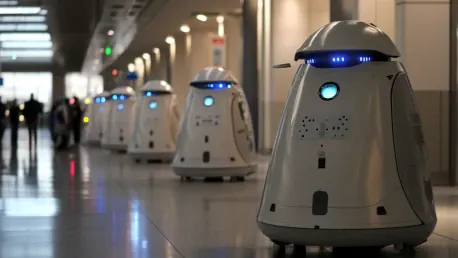The airport robots market is an emerging segment of the broader robotics and automation industry, predominantly driven by the need for operational efficiency, enhanced security, and improved passenger experiences at airports. This analysis delves into the key themes, trends, and insights within the airport robots market, highlighting how AI and robotics are poised to significantly transform airport operations by 2034.
The global airport robots market size was valued at USD 1.18 billion in 2024 and is expected to reach approximately USD 4.29 billion by 2034, growing at a compound annual growth rate (CAGR) of 13.76% from 2025 to 2034. This impressive growth is attributed to the widespread adoption of robotic technology at airports, which enhances operational efficiency, streamlines processes, improves security measures, and elevates the overall customer experience. This transformative journey indicates a future where airports will be safer, more efficient, and more passenger-friendly, driven by the seamless integration of AI and robotic technologies.
Key Market Takeaways
North America led the global airport robots market with the most significant market share of 40% in 2024, showcasing its dominance in technological advancements and adoption. The Asia Pacific region, however, is projected to be the fastest-growing market during the forecast period, indicating a shift towards modernization and technological integration in airport operations within this region. These trends underscore the global enthusiasm for embracing robotic solutions aimed at enhancing airport functionality.
In 2024, the non-humanoid segment was the major contributor by type, primarily due to their efficiency in performing repetitive and mundane tasks that require precision without human intervention. Interestingly, the humanoid segment is anticipated to expand rapidly in the coming years as these robots are designed to mimic human behaviors and perform various tasks, ranging from personal assistance to healthcare, thus complementing human workers in diverse capacities. The terminal segment held the largest market share by application in 2024, driven by the need for improved efficiency and guest services within airport terminals. Conversely, the landside segment is expected to demonstrate significant growth during the forecast period due to robots’ capabilities in passenger identity verification and enhancing overall airport security.
The airport security segment emerged as the largest end-user segment in 2024, focusing on automating screening processes and maintaining stringent security standards. AI-based robots with high-definition cameras and facial recognition software enhance surveillance and detect restricted items, revolutionizing security protocols at airports. Simultaneously, the passenger guidance segment is expected to grow at the fastest CAGR during the forecast period, with robots assisting passengers in navigation, scanning boarding passes, and resolving multilingual queries, ultimately making airport experiences more seamless and less stressful.
Impact of Artificial Intelligence (AI) on the Airport Robots Market
AI is significantly transforming the airport robots market, where robots equipped with advanced AI capabilities are becoming indispensable for ensuring passenger safety and improving overall efficiency. These robots conduct health checks using built-in cameras, sensors, and sophisticated algorithms that measure pulse rate, detect high body temperature, heart rate, and stress levels. This capability became especially relevant during the COVID-19 pandemic, highlighting the importance of maintaining health and safety standards in public spaces like airports.
Furthermore, AI-powered robots are revolutionizing airport security procedures by performing critical tasks such as facial recognition and self-service check-ins, thereby reducing the need for direct human interaction and expediting the security process. These robots can also identify prohibited items, including knives, firearms, and ammunition at security checkpoints, ensuring a higher level of safety for passengers and airport personnel alike. For instance, in August 2024, Moxy Bengaluru Airport Prestige Tech Cloud introduced an advanced autonomous mobile robot designed to enhance the guest experience by offering welcoming cocktails and delivering room service. These AI-powered robots leverage 3D perception RGBD cameras and IoT connectivity to execute tasks with high precision and efficiency, exemplifying how AI and robotics can elevate service standards in airport environments.
U.S. Market Size and Growth
The U.S. airport robots market size was valued at USD 350 million in 2024, demonstrating the country’s significant investment in enhancing airport operations through robotic technology. Expectations point to the market reaching around USD 1,310 million by 2034, growing at a CAGR of 14.10% from 2025 to 2034. North America’s dominance in the global market can be attributed to robust research and development efforts in the robotics field and the increasing adoption of robots aimed at improving passenger safety and convenience.
One prominent example of technological integration is the deployment of autonomous delivery robots at North American airports, responsible for delivering food, beverages, and lifestyle items. These robots facilitate contactless delivery and elevate airport security standards, ensuring a higher level of convenience for passengers. In February 2024, San Antonio airport in Texas introduced the K5 autonomous security robot, showcasing features such as 360-degree eye-level video streaming, people detection during restricted hours, thermal anomaly detection, and license plate recognition. This deployment underscores the advanced security capabilities of airport robots and their potential to enhance safety significantly.
Asia Pacific Market Trends
The Asia Pacific region is set to host the fastest-growing airport robots market during the forecast period, driven by the adoption of cleaning and disinfection robots at airports. These robots perform repetitive tasks with high efficiency, such as cleaning canals, removing rainwater, and maintaining cleanliness in airport premises. The importance of these tasks was accentuated by the pandemic, which necessitated rigorous sanitation protocols to curb the spread of viruses and infectious diseases.
Moreover, robots contribute to environmental sustainability by saving electricity and water usage and reducing the chemicals required for cleaning purposes. The integration of autonomous robots inherently aligns with sustainability goals, offering a dual benefit of operational efficiency and environmental conservation. This dynamic is transforming how airport operations are managed, particularly in regions with high passenger traffic and significant resource constraints, making the deployment of robotic solutions both an economic and environmental imperative.
Market Dynamics: Drivers, Restraints, and Opportunities
Driver: Leveraging Economic Benefits
The robotics sector has demonstrated substantial positive impacts on business and employee productivity across various industries, including airport operations. Investing in machines, computers, and robotics drives better productivity and optimized outputs, making it a critical driver for the airport robots market. Technological advancements in robots and automation are expected to significantly influence the labor market by enhancing labor productivity, economic growth, and job creation. Robots enhance operational accuracy, increase productivity levels, and ensure employee safety by minimizing human errors and proactively detecting potential problems through embedded sensors, providing a compelling case for their widespread adoption in airports.
Restraint: Employment Threats
Despite the numerous advantages offered by robotics, one of the primary concerns is the potential threat to employment, particularly for low-skilled and middle-skilled workers. As robots are increasingly deployed to perform tasks traditionally carried out by humans, there is a risk of job displacement and wage depression. Research indicates that each robot could replace approximately 1,000 workers in the U.S., leading to a decrease in wages by 0.42% and a decline in the employment-to-population ratio by 0.2%. The implementation of robots across various industries, including airport operations, has resulted in job losses, amounting to around 400,000 positions. This dynamic poses a significant challenge that policymakers and industry stakeholders need to address to balance technological advancements with the socio-economic implications on the workforce.
Opportunity: Gaming and Entertainment
An emerging opportunity within the airport robots market is the potential for gaming and entertainment facilities for passengers. Robots can serve as performers or complement human performers, leveraging deep learning technology for interactive entertainment that enhances passenger experiences during their time at the airport. These robots can act as referees, monitor real-time games, and analyze crucial decision events using image recognition, action analysis, and rule matching. The integration of AI, advanced robotics, and creative programming within airport robots products promises to revolutionize airport experiences, transforming waiting times into enjoyable moments for travelers, thereby adding substantial value to airports’ service offerings.
Segment Insights
Type Segment
The non-humanoid segment accounted for the major share of the airport robots market in 2024, with these robots being instrumental in performing repetitive tasks. Cleanliness, passenger navigation, security checks, scanning boarding passes, and identifications are among the primary functions non-humanoid robots efficiently handle. Their deployment results in increased productivity, enhanced safety, and reduced labor costs, making them indispensable in modern airport operations. However, the humanoid segment is projected to grow rapidly due to increasing labor shortages in many countries. Humanoid robots, designed to mimic human behavior, are adept at performing various tasks, including personal assistance, caregiving, entertainment, rescue operations, and healthcare, complementing human workers and filling critical gaps in the workforce.
Application Segment
Driven by the need to improve operational efficiency, the terminal segment captured the largest market share in 2024. Robots ensure that terminals remain clean and allow human staff to focus on more critical tasks, like customer service. Airports employ these robots for runway maintenance and terminal building construction, while some airports deploy autonomous AI-powered robots to assist passengers with disabilities or immobility. Robots also play significant roles in the landside segment, where they are expected to grow notably due to their biometric capabilities for passenger identity verification, enhancing security, and reducing wait times. These AI robots manage airport parking, maintain accurate records, and facilitate seamless payment processes, contributing to a smoother experience for all travelers.
End-user Segment
The airport security segment held the highest market share in 2024, driven by the adoption of advanced robotic systems that automate screening processes and uphold stringent security standards. High-definition cameras, facial recognition software, and AI-based robots contribute significantly to airport surveillance and overall safety. They automatically detect restricted items, ensuring a secure environment for passengers and staff. Meanwhile, the passenger guidance segment is anticipated to grow at the fastest rate. Robots in this segment improve navigation, guide passengers to departure gates, and assist with queries in multiple languages, making the airport experience less stressful and more streamlined.
Robotic Systems in Airports
Robotic systems are integral to various airport operations, ranging from construction and maintenance to staffing check-in desks, enforcing security protocols, cleaning premises, and delivering food to passengers. Technological advancements and economic pressures have driven the adoption of robotic solutions, reducing labor costs and improving profitability. The ongoing digital transformation at airports involves seamlessly integrating existing systems with automation and robotics, thereby enhancing operational efficiency, security, and passenger-focused performance.
According to Air Transport IT insights, more than half of global airlines and 32% of airports are seeking partnerships to enhance robotic involvement in their operations. SITA’s Air Transport IT Insights 2023 report indicated that 18% of airlines plan to incorporate major robotics and autonomous machine programs by 2026, underlining the growing importance of robotics in the future of air travel.
Future Prospects and Developments
Recent developments highlight the increasing integration of robots in airport operations. For example, in December 2024, Thiruvananthapuram International Airport, managed by Adani Airport Holding Limited (AAHL), introduced intelligent cleaning robots to enhance passenger experience and operational efficiency. Similarly, A&K Robotics launched self-driving robotic pods at Vancouver International Airport (YVR) in August 2024 to assist passengers with mobility and guidance needs. These examples reflect the broader trend towards embracing robotics to handle various aspects of airport management and passenger services.
Corporate announcements and initiatives by leading industry players also underscore this trend. In December 2024, SITA partnered with IDEMIA to integrate computer vision into baggage processing, addressing challenges in baggage handling and improving overall security and efficiency. These collaborations and innovations indicate a robust future for airport robots, with continuous advancements and strategic partnerships driving the evolution of airport operations.
Conclusion
The robotics sector has shown significant positive impacts on business and employee productivity across multiple industries, including airport operations. Investing in machines, computers, and robotics enhances productivity and optimizes outputs, making it crucial for the airport robots market. Technological advancements in robotics and automation are projected to dramatically affect the labor market by boosting labor productivity, driving economic growth, and creating new jobs. Robots improve operational accuracy, increase productivity levels, and ensure employee safety. They minimize human errors and proactively detect potential issues through embedded sensors. This compelling combination presents a strong case for their widespread adoption in airports.
These technological improvements allow robots to perform tasks with greater precision and efficiency. For instance, airport robots can handle luggage, assist travelers with directions, and conduct security checks, significantly reducing the workload of human staff and allowing them to focus on more complex tasks. Moreover, robots equipped with advanced sensors can anticipate and resolve issues before they escalate, providing a safer environment for both employees and passengers. As a result, the integration of robotics in airport operations is not just a trend but a transformative approach that promises to reshape the future of the industry, setting new standards for efficiency, safety, and customer service.









